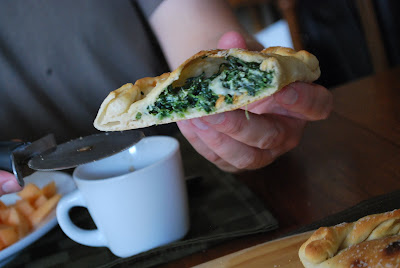We are back in
Dakota territory. Our recent trip to South Dakota did not provide much in terms of inspiration for our meal, though we did
eat well. South Dakota has two official state foods: kuchen is the state dessert, and fry bread is the state bread. The state is rich in both Native American and frontier traditions (often, of course, these two met with
tragic results).
The Ingalls family might be South Dakota's most famous pioneers. One place we didn't get to visit during our vacation this summer was DeSmet, the home of the Ingalls family for many years and the site of Little Town on the Prairie and The Long Winter. For this dinner, we decided to honor Ma Ingalls and prepare one of the most commonly mentioned meals in the Little House series: Chicken Pie.

You might remember in Little Town on the Prairie, a plague of blackbirds descends upon the crops of corn and oats. Pa guards the fields with his shotgun, bringing down hoards of the birds. Ma, never one to waste anything, baked the blackbirds into a pie, which the family declared better than the chicken pie. I opted for chicken for our meal.
Chicken pie gets a lot of mention in pioneer cooking, but it was difficult to find an actual recipe. This seems to be a dish that every one just knows how to make, or each cook has her own way of doing it. As a kid, Swanson's frozen Chicken Pot Pies made the occasional appearance on our table, and they were always one of my favorites. We made a basic chicken pie filling, though with fewer vegetables than what you might find in the frozen varieties.
Marc was in charge of the filling. Since it is easier to get the meat off of the bone if it's cooked, he started by roasting two thigh/leg quarters. These came from one of our favorite local meat
suppliers.

Season with salt and pepper and sear the meat in 1 T olive oil, skin-side down, over medium high heat, so that it gets brown and crispy. Then roast the pieces in the oven at 425 degrees until the meat is done (15-20 minutes). We threw some potatoes in to roast too, these will be eaten later as leftovers rather than in the chicken pie.
While the meat is cooking, dice one large onion, a few stalks of celery and a few carrots. When the meat is done, remove it from the pan and set aside. When it's cool enough to handle, remove the meat from the bones. Discard the skin and save the bones for stock later.
Now you can use the good pan drippings for the base of the sauce. Over medium heat, whisk about 1/3 cup of flour to the pan drippings and continue stirring until it forms a paste (congratulations, you've just made a roux!). If the chicken hasn't rendered enough fat naturally, feel free to add some butter or oil here. You want about equal parts fat and flour for a roux.

Add the vegetables to the roux and cook until they soften slightly, then add chopped garlic, thyme salt and pepper, followed by the chicken meat. Blend everything together well and slowly add about 2 cups of chicken stock. You want to make sure the roux is well incorporated into the stock. If you like a thinner consistency, add more stock.
The filling can be made ahead. You want it to be at least room temperature before you introduce the crust.
I'm the official pie-crust maker in our family am generally of the point of view that any food is improved when enclosed in pastry. I used my standard method for one pie crust--1 cup of flour, 1/3 cup butter and a pinch of salt. Cut the cold butter into the flour and salt with a pastry blender and add just enough ice water for the dough to come together. This is usually about 1/4 cup for me. I divided the dough into fourths and made each into a flat circle. These were individually wrapped in saran wrap and refrigerated while the oven came up to temperature.
Rather than make one large pie, I used little ramekins that I found at a thrift store for $.50 a piece. These are perfect for individual macaroni and cheese or desserts. When the dough had cooled (cold dough is easier to work with and results in a flakier crust), Lucy helped me roll it out.

I divided the filling evenly between four ramekins--about 3/4 cup of filling each, and topped with a crust. These baked at 375 degrees for about 25 minutes.

So, after all that work, how did it go? Both kids were horrified at the appearance of the filling. They are averse to any mixed, mushy or soupy foods, so I wasn't sure how this would go over. Maia tried hers right away and deemed it "OK" (interpreted
here). Lucy spent a lot of time talking about it and poking at it before she would take a bite. When she did try it, it was only to pick off some crust. One can't try the crust without the filling, however, and she found the flavor of the sauce to her liking. This resulted in much more conversation about what "savory" means and how interesting it is that everything in the sauce tastes like the sauce, even if it's something you don't normally like (like a cooked carrot) etc, etc... In the end, she was completely won over and declared that chicken pie would be a fine addition to the fall and winter dinner rotation.
Whew.
Next: back east (a little) to Michigan

 On the side, fresh cherries, of course!
On the side, fresh cherries, of course!










































